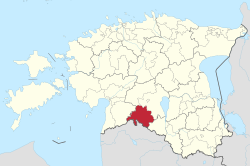Loading AI tools
Municipality of Estonia From Wikipedia, the free encyclopedia
Mulgi Parish (Estonian: Mulgi vald) is a rural municipality in southern Estonia. It is a part of Viljandi County.[1] As of 2021, the municipality has a population of 7,372,[2] and covers 881 km2 (340 sq mi).
Mulgi Parish
Mulgi vald | |
|---|---|
 Mulgi Parish within Mulgi County. | |
| Country | |
| County | |
| Administrative centre | Abja-Paluoja |
| Government | |
| • Mayor | Imre Jugomäe |
| Area | |
| • Total | 881 km2 (340 sq mi) |
| Population (2019) | |
| • Total | 7,436 |
| • Density | 8.4/km2 (22/sq mi) |
| ISO 3166 code | EE-480 |
The administrative centre of the Mulgi municipality is the town of Abja-Paluoja. The municipality itself consists of 3 towns (Abja-Paluoja, Karksi-Nuia, Mõisaküla); 2 small boroughs (Estonian: alevikud) (Halliste, Õisu); and 58 villages: Abja-Vanamõisa, Abjaku, Ainja, Allaste, Äriküla, Atika, Ereste, Hirmuküla, Hõbemäe, Kaarli, Kalvre, Kamara, Karksi, Kõvaküla, Kulla, Laatre, Lasari, Leeli, Lilli, Mäeküla, Maru, Metsaküla, Mõõnaste, Morna, Mulgi, Muri, Naistevalla, Niguli, Oti, Päidre, Päigiste, Pärsi, Penuja, Põlde, Polli, Pöögle, Pornuse, Räägu, Raamatu, Raja, Rimmu, Saate, Saksaküla, Sammaste, Sarja, Sudiste, Suuga, Tilla, Toosi, Tuhalaane, Ülemõisa, Umbsoo, Univere, Uue-Kariste, Vabamatsi, Vana-Kariste, Veelikse, and Veskimäe.
This section is empty. You can help by adding to it. (June 2024) |
The municipality was formed on the 24th October, 2017, by merging of the town of Mõisaküla with the neighbouring municipalities of Karksi, Abja, and Halliste.[3]
There were many discrepancies in the past based on the naming of the Mulgi municipality; the naming council found Mulgi to be a misleading name both culturally and geographically,[4] as the municipality only covers a third of the historical Mulgimaa – the municipalities of Halliste and Karks, to be more specific. Suggested names in its place included Lääne-Mulgi, Abja-Mulgi, and Halliste-Karksi.
Concerns have also been raised about the loss of the name Abja. This stems from the history of the area; before the expansion of the Viljandi county (Raion) borders in 1962, the raion of Abja also existed in about the same area.[5]
The area has been a developed flax growing region and was one of the most prosperous in Estonia in the 19th century. Flax cultivation is also the reason why flax flowers are depicted on regional symbols.
Seamless Wikipedia browsing. On steroids.
Every time you click a link to Wikipedia, Wiktionary or Wikiquote in your browser's search results, it will show the modern Wikiwand interface.
Wikiwand extension is a five stars, simple, with minimum permission required to keep your browsing private, safe and transparent.